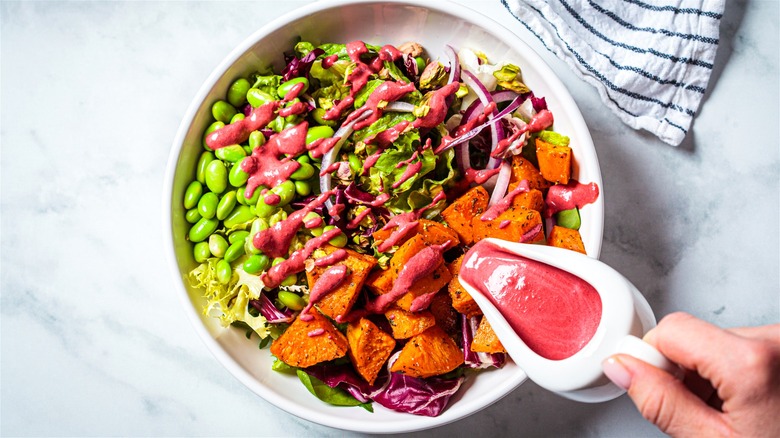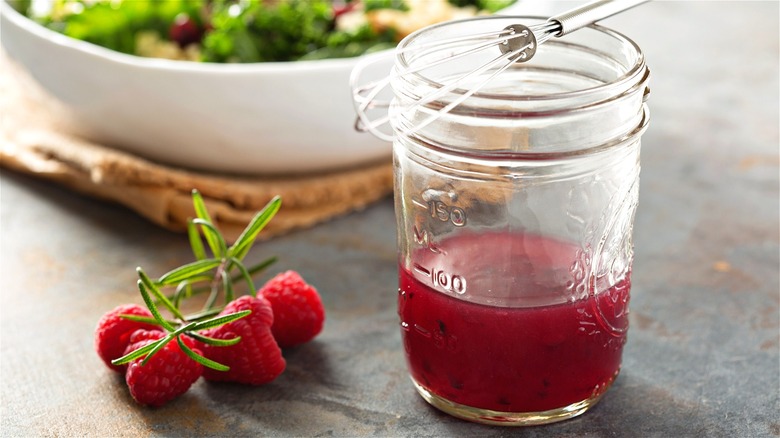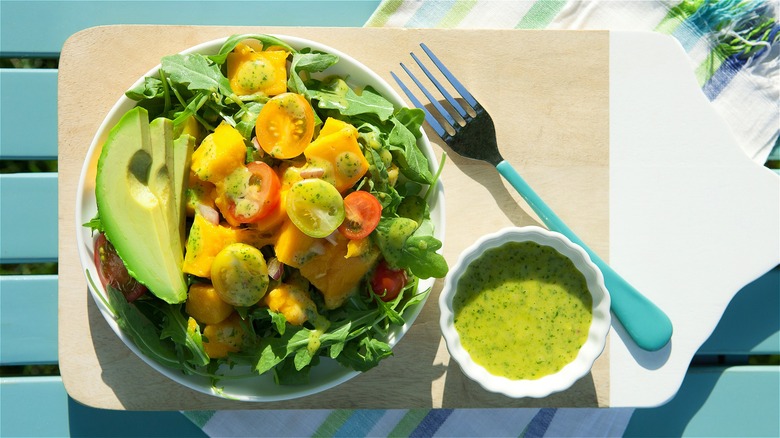Amp Up Your Salad Dressings With Some Pureed Fruits And Vegetables
What if there was a surefire way to rejuvenate the flavor of salad and salad dressing recipes? While the more obvious tactics to amp up your usual plate of freshly chopped produce includes trying different proteins, making homemade croutons, and even utilizing a veggie peeler to give your meal a new and unexpected texture, sometimes the quickest way to add more flavor to your daily salad involves completely overhauling the ingredients in your salad dressing. Most salad dressing varieties contain somewhat equal parts acid and oil, while also including signature extras, such as fat for creamy dressings, thickeners such as honey, jam, or mustard, fresh herbs, and a dry blend of seasonings. But if you're looking for a completely different way to breathe new life into your next batch of salad dressing, look no further than the produce aisle.
With small amounts of oil and citrus juice or vinegar, you can craft perfectly creamy and colorful salad dressings out of fruits and vegetables. The best part about making these new and improved dressings is the fact that some varieties don't require extra prep, such as cooking or roasting. As long as you have a high-powered blender and an open mind, you can make vibrant salad dressings with just the right amount of raw produce, oil, acid, and your favorite herbs and spices.
Adding fresh produce to salad dressing couldn't be easier
No matter how many new and exciting vegetables, fruits, and toppings you use to prepare an epic salad, sometimes the upgrade that feels the most impactful pertains to the ingredient that brings the entire dish together: the salad dressing.
To amp up a basic vinaigrette with some fresh produce, first consider the theme of your salad. If you usually make a salad dressed in goat cheese, chicken, pecans, and strawberries, for example, why not bring this dish together by adding a handful of puréed strawberries to your standard mix of oil, vinegar, salt, and mustard? For fruit-based dressings, choose fruit already present in the mix of ingredients to amplify those specialty flavors. If you like a sweeter dressing, add a bit of honey to your dressing — it will also serve as a sufficient thickener.
The same advice applies to veg-heavy salads. If you find yourself sautéing some vegetables to add to a warm, comforting dinner salad, save a portion and add these chopped foods to your dressing mix. Not only does adding fresh produce make salad dressing more nutritious, as you'll be adjusting the ratios of oil and vinegar, but these additions also add a powerful punch of flavor. While adding a handful or two of fresh produce is an easy up to upgrade any dressing, there's also a way to use fresh produce to make deliciously creamy salad dressings.
How to make creamy, flavorful fruit- and vegetable-based salad dressings
Even though ranch dressing recipes often require a hefty amount of mayo, you can make a new subset of creamy salad dressings with just raw produce, oil, and a working blender. Certain vegetables and fruits, such as avocado and zucchini, can be transformed into herb-based dressings with enough oil, citrus juice, and even a bit of water to thin out the consistency. When blended, these green foods transform into a creamy mixture that pairs well with a multitude of fresh herbs and seasonings.
You can make other deliciously creamy dressings with veggies, too. By using soaked and blended cashews, as opposed to sour cream or mayo, you can create ultra-creamy dairy-free dressings with cooked beets, or raw carrots and corn. Tahini, a paste made from sesame seeds, is also a good alternative when you want a heartier dressing.
When making vegetable-based sauces, you'll need to experiment to procure the proper balance of acid and oil (citrus juice provides a great zing of flavor). You may also need to add a bit of water to thin out the texture. With the help of a high-powered blender, adding fresh produce to your standard mix of oil and vinegar is a great way to up the overall taste of your next salad.


